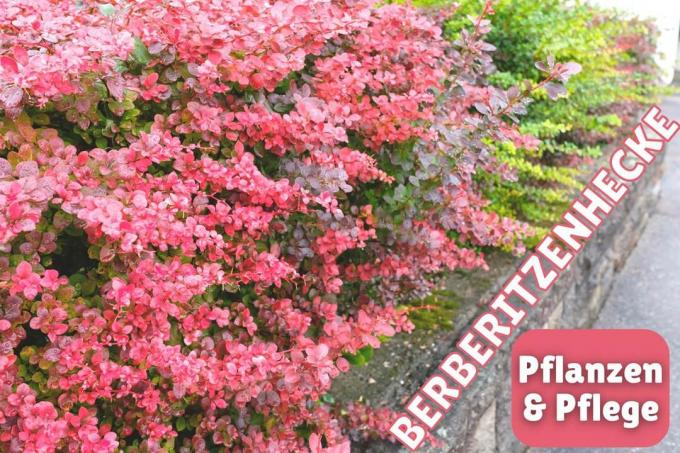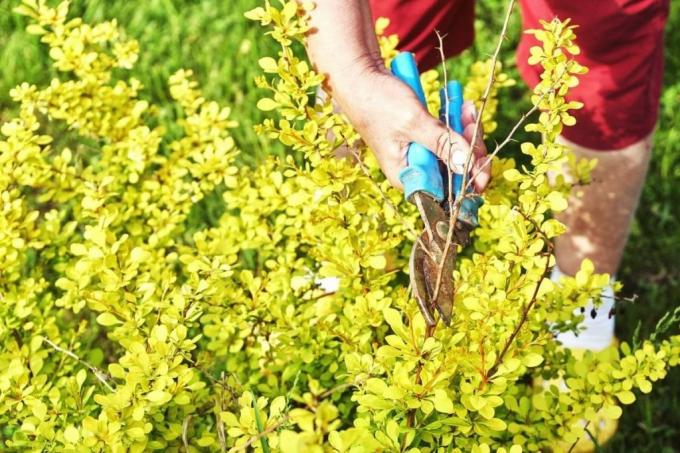
table of contents
- Suitable varieties
- preparation
- Distance and plants
- time
- care
- Soil condition and location
- Watering and fertilizing
- Diseases and pests
- Cut
- Multiply
- frequently asked Questions
Profile and care information open +conclude -
- Flower color
- yellow
- Location
- Shade, partial shade, shady, sunny
- Heyday
- May June
- Growth habit
- bushy
- height
- up to 300 centimeters
- Soil type
- sandy, loamy
- Soil moisture
- moderately dry, moderately moist, fresh
- PH value
- weakly alkaline, weakly acidic, acidic
- Limescale tolerance
- Calcium tolerant
- humus
- rich in humus
- Poisonous
- Yes
- Plant families
- Barberry Family, Berberidaceae
- Plant species
- Hedge plants, Bushes
- Garden style
- Cottage garden, natural garden, park
Despite her thorns, she is Barberry very well suited for a hedge due to their low demands on care and location. Because it grows very densely, the barberry hedge can withstand prying eyes from the outside.
Suitable varieties
A barberry hedge is ideally suited for all locations, because it can adapt to both heat and drought and also tolerates the urban climate very well. In addition, the plants are easy to care for, hardy and can easily tolerate pruning. There are different varieties that are well suited as a hedge barberry in the local latitudes.

| Surname | Growth rate speed (in cm / year) |
Height | Growth width | characteristics |
|---|---|---|---|---|
| Common barberry (Berberis vulgaris) |
20 to 50 | up to 3 meters | up to 1.5 meters | Bee pasture, bird-friendly, uncomplicated, hardy |
| Barberry (Berberis thunbergii 'Atropurpurea') |
20 to 40 | up to 3 meters | up to 2 meters | red leaves, bee pasture, bird-friendly, very hardy |
| Small barberry (Berberis thunbergii 'Atropurpurea Nana') |
5 to 8 | up to 50 centimeters | up to 1 meter | Bee pasture, slow growing, hardy |
| Large-leaved barberry (Berberis julianae) |
30 to 40 | up to 3 meters | up to 3 meters | evergreen |
| Barberry 'Telstar' (Berberis frikartii 'Telstar') |
15 to 25 | up to 2 meters | up to 2 meters | evergreen |
| Barberry 'Amstelveen' (Berberis frikartii 'Amstelveen') | 5 to 15 | up to 1 meter | up to 1 meter | evergreen, very undemanding |
preparation
Planting a barberry hedge takes some preparation. Because the soil in which the plants are cultivated should already provide enough nutrients from the point of planting. It is therefore advisable to add the garden soil two months before the actual planting day compost to mix, fold it in well and let it rest for the next few weeks:
- Compost is slow to decompose in the soil
- required nutrients are only released after a few weeks
- The nutrients are ready for the planting date
- At the same time, create a drainage along the entire length
- can avoid waterlogging
- Fill in a layer of gravel in dug strips
- then give the prepared earth
Distance and plants
The distance between the individual plants in the barberry hedge is important so that they do not interfere with each other's growth and the formation of new shoots and leaves. Balding in the interior can also be prevented with a sufficient distance. In addition, when creating the hedge, care should be taken to ensure that it is absolutely straight:

- Stake out along the desired course of the hedge
- To do this, stick small sticks into the ground at both ends
- tighten a rope
- dig the planting holes along here
- at a distance of about half a meter
- Simply insert bare-root goods
- Bale or container goods soak the roots in water beforehand
- Fill in the soil and press firmly
- make sure the bushes are standing straight
- Water well immediately and water well every day for the first few weeks
It is a good idea to spread a layer of mulch along the hedge on the ground so that the moisture can be retained in the soil. It is also important to shorten all shoots by a third so that the young bushes can branch out lushly.
Tip: Ideally, you have already stretched the straight rope the first time you dig it out and prepare the earth, because so the trench can be seen later and the drainage is also laid out exactly where it makes sense power.
time
The ideal time to plant the barberry is in spring, after the ground is no longer frozen. Then the plants have long enough time to grow and form new roots. Alternatively, there are also other times:
- in autumn before the first frost
- straight balls and bare roots
- Container goods can be planted all year round
- Do not place evergreen plants in a sunny location in autumn
- then leaves could burn in the first year
Note: While year-round planting is recommended, you should make sure that the ground is no longer frozen in winter or early spring. Otherwise it will be very difficult for you to dig the planting holes.
care
When it comes to care, all barberry hardly makes any demands on the location requirements as well as on watering, fertilizing and cutting. Therefore, these plants are equally suitable for every garden. You should only pay attention to the desired height and whether it is an evergreen or a deciduous variety.
Soil condition and location
The hedge barberry can be grown in many locations, which makes it a popular hedge plant:

- prefers a predominantly sunny location
- penumbra can also be chosen
- only a fully shaded location should be avoided with most varieties
- the substrate should be permeable and slightly humus
- moderately dry to moderately moist
- acidic to alkaline garden soil
- Mix with compost before first planting
Watering and fertilizing
Immediately after planting, it is important that the barberry hedge grows well and that it receives enough water:
- Water regularly for the first few weeks
- after that, of course, falling rain is sufficient
- only pour additional water during long dry phases
- fertilize regularly in spring
- Work in compost along the barberry hedge
- alternatively choose organic fertilizer for shrubs
Diseases and pests
Unfortunately, the barberry hedge also has to struggle with various diseases and pests:
Aphids

- on blossoms
- Spray with a hard water jet several times a day
Vine weevil
- attack and eat leaves
- Collect beetles in the dark
- Use a flashlight
- Larvae in the soil damage the roots
- Give nematodes from the trade with the irrigation water
Powdery mildew
- attacks the leaves
- in a hedge can only be managed with fungicides
Cut
All types of barberries are easy to cut. For this reason, too, the bushes are well suited for a hedge. In addition, barberries are very slow-growing shrubs that only need one cut per year:
- Hedges only between 01. October and 28. February cut
- according to Nature Conservation Act
- Choose a dry, frost-free and overcast day
- remove all dried branches
- right at the base
- Cut to the desired height and width
- hedge trimmers can be used for this
- Only make light cuts over the summer
- for example, long, disturbing shoots with a pair of secateurs

If an old hedge is bare and is no longer growing nicely, it can even be radically pruned back to the base in the permitted time described above. Here it drives out again without any problems, but due to the slow growth it can take a while until a new privacy screen has grown.
Note: Since every type of shrub has very long and pointed thorns, you should protect yourself with long trousers, long sleeves and sturdy gardening gloves when cutting.
Multiply
Should an existing barberry hedge be repaired or extended, or another Barberry hedge is created in the garden, then new barberry hedge does not necessarily have to be created here can be acquired. Because the bushes can be easily propagated using cuttings. However, in such a case a little more patience is required when growing the hedge:
- Use half-lignified cuttings
- are cut in summer
- alternatively cuttings
- are won in autumn
- simply put your two lower eyes in the ground
- ideally where the barberries should grow
- either as a stopgap in an existing hedge
- or use a new hedge as a privacy screen
- early enough before the first frost
- survive the winter
Alternatively, the cuttings can also be grown in pots. To do this, they are placed in a bright, not too warm place, regularly kept moist and planted in the desired location in spring.
Note: Often small new shrubs also form from seeds under the mother plants. These can also be removed and replanted elsewhere. However, these are mostly not single-variety specimens, as is the case with cuttings.
frequently asked Questions
The barberries can tolerate everything except a completely shady location with no sunlight. However, when choosing the plants for a planned location, you should make sure that the evergreen varieties are the Prefer partial shade, whereas the deciduous varieties can cope with full sun and planted here without any problems can be.
The biggest difference here is in the price, because the bale goods are significantly cheaper. Bare-root shrubs, which are treated in the same way as the root ball during planting, are even cheaper. Because there is a difference here too. While the barberries delivered in containers can be planted all year round, baled goods should be cultivated in autumn or spring. In addition, container goods can also be left standing after they have been purchased. Bales or bare-root bushes should go directly into the soil.
There are no general rules for this, but you should always talk to your neighbor and ask about the guidelines of the community in which you live. However, it is important to maintain a good relationship with your neighbors and at least inform them of the establishment of a barberry hedge along your property.
There is a good rule of thumb here that should be used especially for container goods. You should never plant the shrubs higher or lower than they have already been. In this way, the root disc can be flush with the ground here. In the case of balled goods and bare-rooted plants, you will see a discoloration at the root neck, which indicates the previous planting depth.



